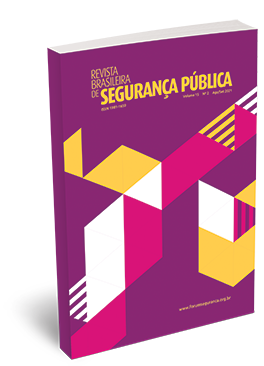Mobility patterns and modus operandi of crime rapes in Maceió (AL)
DOI:
https://doi.org/10.31060/rbsp.2021.v15.n2.1280Keywords:
Criminal mobility, Modus operandi, Rape crimesAbstract
The article presents a characterization of criminal mobility and modus operandi of rape crimes that occurred in the city of Maceió (AL, Brazil) between the years 2015 and 2017. The data gathered in the study were provided by the Civil and Military Police and by the Alagoas State Re-socialization and Social Inclusion Secretariat. A descriptive approach was used to describe the configurational aspects of rapes reported in the city in the period mentioned above. In the analysis of the results, it was possible to identify patterns in the way in which the aggressors acted, in the profiles of the victim and of the offender and in the spatiotemporal configurations of rape crimes on the urban perimeter of the capital of Alagoas state.
Downloads
References
AINSWORTH, P. Offender profiling and crime analysis. Devon: Willan Publishing, 2013.
BEATO, C. Crime e cidades. 2 ed. Belo Horizonte: Editora da UFMG, 2012.
BEATO, C.; ASSUNÇÃO, R. M.; SILVA, B. F. A. da; MARINHO, F. C.; REIS, I. A.; ALMEIDA, M. C. de M. Conglomerados de homicídios e o tráfico de drogas em Belo Horizonte, Minas Gerais, Brasil, de 1995 a 1999. Cadernos de Saúde Pública, v. 17, n. 5, p. 1163-1171, set./out. 2001.
BEAUREGARD, E.; BUSINA, I. Journey “during” crime: predicting criminal mobility patterns in sexual assaults. Journal of Interpersonal Violence, v. 10, n. 28, p. 52-67, 2013.
BEAUREGARD, E.; MARTINEAU, M. Journey to murder: examining the correlates of criminal mobility in sexual homicide. Police Practice and Research, v. 17, n. 1, p. 68-83, 2016.
BERNASCO, W.; NIEUWBEERTA, P. How do residential burglars select target areas? A new approach to the analysis of criminal location choice. British Journal of Criminology, v. 45, n. 3, p. 296-315, maio 2005.
BLOCK, R.; GALARY, A.; BRICE, D. The journey to crime: victims and offenders converge in violence index offenses in Chicago. Security Journal, v. 20, n. 2, p. 123-137, 2007.
BRANTINGHAM, P.; BRANTINGHAM, P. Notes on the geometry of crime. In: CANTER, D.; YOUNGS, D. (Eds.). Principles of geographical offender profiling. New York: Routledge, 2017, p. 97-124.
BRANTINGHAM, P.; BRANTINGHAM, P. Crime pattern theory. In: WORTLEY, R.; MAZEROLLE, L. (Eds.). Environmental criminology and crime analysis. Devon: Willan Publishing, 2008, p. 78-93.
BRANTINGHAM, P.; BRANTINGHAM, P. Environment, routine and situation: toward a pattern theory of crime. In: CLARKE, R.; FELSON, M. (Eds.). Routine activity and rational choice. New Brusnwick: Transactions, 1993, p. 259-294.
BRANTINGHAM, P.; BRANTINGHAM, P. Patterns in crime. New York: MacMillan, 1984.
BRASIL. Ministério da Mulher, da Família e dos Direitos Humanos. Dados do Disque 100.
BRASIL. Lei nº 13.718, de 24 de setembro de 2018. Altera o Decreto-Lei nº 2.848, de 7 de dezembro de 1940 (Código Penal), para tipificar os crimes de importunação sexual e de divulgação de cena de estupro, tornar pública incondicionada a natureza da ação penal dos crimes contra a liberdade sexual e dos crimes sexuais contra vulnerável, estabelecer causas de aumento de pena para esses crimes e definir como causas de aumento de pena o estupro coletivo e o estupro corretivo; e revoga dispositivo do Decreto-Lei nº 3.688, de 3 de outubro de 1941 (Lei das Contravenções Penais). Diário Oficial da União, Rio de Janeiro, 25 set. 2018.
CAMPOS, M. da S. Escolha racional e criminalidade: uma avaliação crítica do modelo. Revista da SJRJ, v. 15, n. 22, p. 93-110, 2010.
CECCATO, V. Homicide in São Paulo, Brazil: assessing spatial-temporal and weather variations. Journal of Environmental Psychology, v. 25, n. 3, p. 307-321, set. 2005.
CERQUEIRA, D.; COELHO, D. S. C. Estupro no Brasil: uma radiografia segundo os dados da Saúde. Brasília: Ipea, 2014.
COHEN, L.; FELSON, M. Social change and crime rate trends: a routine activity approach. American Sociological Review, v. 44, n. 4, p. 588-608, ago. 1979.
CORNISH, D. B. The procedural analysis of offending and its relevance for situational prevention. In: CLARKE, R. (Ed.). Crime Preventions Studies. v. 3, Monsey: Criminal Justice Press, 1994, p. 151-196.
CORNISH, D. B.; CLARKE, R. V. Opportunities, precipitators and criminal decisions: a reply to Wortley’s critique of situational crime prevention. In: SMITH, M. J.; CORNISH, D. B. (Eds.). Crime Prevention Studies: theory for practice in situational crime prevention. Monsey: Criminal Justice Press, 2003, p. 41-96.
CORNISH, D. B.; CLARKE, R. V. The rational choice perspective. In: WORTLEY, R.; MAZEROLLE, L. (Eds.). Environment criminology and crime analysis. Cullompton: Willan, 2008, p. 21-47.
COUPE, T.; BLAKE, L. Daylight and darkness targeting strategies and the risks of being seen at residential burglaries. Criminology, v. 44, n. 2, p. 431-464, jun. 2006.
DELFINO, M. S. Entre muros: descrição espacial dos cenários urbanos com grande incidência criminal em Maceió-AL. 2017. Dissertação (Mestrado em Arquitetura e Urbanismo) – Programa de Pós-Graduação em Arquitetura e Urbanismo, Universidade Federal de Alagoas, Maceió, 2017.
DUWE, G.; DONNAY, W.; TEWKSBURY, R. Does residential proximity matter? A geographic analysis of sex offense recidivism. Criminal Justice and Behavior, v. 35, n. 4, p. 484-504, 2008.
ECK, J. The crime-place Chacham*. Criminology & Public Policy, v. 17, n. 1, p. 27-30, 2018.
ECK, J. Preventing crime at places. In: SHERMAN, L. W.; FARRINGTON, D. P.; WELSH, B. C.; MACKENZIE, D. L. (Eds.). Evidence-based crime prevention. New York: Routledge, 2002, p. 241-294.
ECK, J. A general model of the geography of illicit retail marketplaces. In. ECK, J.; WEISBURD, D. (Eds.). Crime prevention studies: crime and place. v. 4, Monsey: Criminal Justice Press, 1995, p. 67-93.
ECK, J. The threat of crime displacement. Criminology Justice Abstracts, v. 25, p. 527-546, 1993.
ENGEL, C. L. As atualizações e a persistência da cultura do estupro no Brasil. Texto para discussão 2339 – Ipea, Brasília: Rio de Janeiro: Ipea, 2017.
G1. Política. Entenda a lei de importunação sexual, que já levou à prisão de foliões no carnaval. Por G1, Brasília, 4 mar. 2019.
FELSON, M.; BOBA, R. Crime and everyday life. [s.l.]: Sage, 2010.
FONTES, L. Não é não! Mas violência sexual aumenta 50% durante o Carnaval em BH. O Tempo, Belo Horizonte, 26 jan. 2020.
FBSP – FÓRUM BRASILEIRO DE SEGURANÇA PÚBLICA. 13º Anuário Brasileiro de Segurança Pública. 2019.
GABOR, T.; GOTTHEIL, E. Offender characteristics and spatial mobility: an empirical study and some policy implications. Canadian Journal of Criminology, v. 26, n. 3, p. 267-281, 1984.
HAGEDORN, J.; RAUCH, B. Housing, gangs, and homicide: what we can learn from Chicago. Urban Affairs Review, v. 42, n. 4, p. 435-456, mar. 2007.
JACOBS, B. Robbing drug dealers: violence beyond the law. New York: Routledge, 2017.
JOHNSON, S.; GUERETTE, R.; BOWERS, K. Crime displacement: what we know, what we don’t know, and what it means for crime reduction. Journal of Experimental Criminology, v. 10, n. 4, p. 549-571, dez. 2014.
LEBEAU, J. The journey to rape: geographic distance and the rapist’s method of approaching the victim. Journal of Police Science and Administration, v. 15, n. 2, p. 129-136, 1987.
LECLERC, B.; PROULX, J.; LUSSIER, P.; ALLAIRE, J. F. Offender-victim interaction and crime event outcomes: modus operandi and victim effects on the risk of intrusive sexual offences against children. Criminology, v. 47, n. 2, p. 595-618, 2009.
LECLERC, B.; TREMBLAY, P. Strategic behavior in adolescent sexual offenses against children: linking modus operandi to sexual behaviors. Sexual Abuse: A Journal of Research and Treatment, v. 19, n. 1, p. 23-41, abr. 2007.
LECLERC, B.; WORTLEY, R.; SMALLBONE, S. Investigating mobility patterns for repetitive sexual contact adult child sex offending. Journal of Criminal Justice, v. 38, n. 4, p. 648-656, jul. 2010.
LUSSIER, P.; BOUCHARD, M.; BEAUREGARD, E. Patterns of criminal achievement in sexual offending: unravelling the “successful” sex offender. Journal of Criminal Justice, v. 39, n. 5, p. 433-444, 2011.
MADDAN, S.; PAZZANI, L. Sex Offenders: crime and processing in the criminal justice system. New York: Wolters Kluwer, 2017.
MELO, S. N. de; BEAUREGARD, E.; ANDRESEN, M. A. Factors related to rape reporting behavior in Brazil: examining the role of spatio-temporal factors. Journal of Interpersonal Violence, v. 34, n. 10, p. 2013-2033, maio 2019.
MOGAVERO, M.; KENNEDY, L. The social and geographic patterns of sexual offending: is sex offender residence restriction legislation practical?. Victims & Offenders, v. 12, n. 3, p. 401-433, 2017.
MOREIRA, G. C.; CECCATO, V. A. Gendered mobility and violence in the São Paulo metro, Brazil. Urban Studies, v. 58, n. 1, p. 203-222, jan. 2020.
NASCIMENTO, F. L. Dinâmicas intraurbanas e mobilidade criminal: uma análise “ecológica” da criminalidade em Maceió (AL). 2020. Dissertação (Mestrado em Sociologia) – Programa de Pós-Graduação em Sociologia, Universidade Federal de Alagoas, Maceió, 2020.
NASCIMENTO, F. L. Dinâmicas intra-urbanas e mobilidade criminal na cidade de Maceió (AL). In: NASCIMENTO, E. O. (Org.). Crime, controle e punição: estudos sobre segurança pública em Alagoas. Maceió: Edufal, 2019, p. 151-187.
NEE, C. Understanding expertise in burglars: From pre-conscious scanning to action and beyond. Aggression and Violent Behavior, v. 20, p. 53-61, 2015.
PETROSINO, A.; BRENSILBER, D. The motives, methods and decision-making of convenience store robbers: interviews with 28 incarcerated offenders in Massachusetts. In: SMITH, M. J.; CORNISH, D. (Eds.). Crime preventions studies: theory for practice in situational crime prevention. v. 16. Monsey: Criminal Justice Press, 2003, p. 237-263.
RATCLIFFE, J. The spatial extent of criminogenic places: a changepoint regression of violence around bars. Geographical Analysis, v. 44, n. 4, p. 302-320, out. 2012.
SUMMERS, L.; ROSSMO, K. Aplicaciones prácticas de la teoría de las actividades rutinarias a la investigación criminal. In: LLINARES, F. M.; SANLLEHÍ, J. R. A.; SARMIENTO, J. F. M.; SUMMERS, L. (Eds.). Crimen, oportunidad y vida diaria. Libro homenaje al Profesor Dr. Marcus Felson. Madrid: Dykinson, 2015, p. 171-186.
TEWKSBURY, R.; MUSTAINE, E. E. Where to find sex offenders: an examination of residential locations and neighborhood conditions. Criminal Justice Studies, v. 19, n. 1, p. 61-75, mar. 2006.
TILLYER, M. S.; WILCOX, P.; WALTER, R. Crime generators in context: examining ‘place in neighborhood’ propositions. Journal of Quantitative Criminology, v. 37, p. 517-546, jan. 2020.
VANDEVIVER, C.; DAELE, S. V.; BEKEN, T. V. What makes long crime trips worth undertaking? Balancing costs and benefits in burglars’ journey to crime. British Journal of Criminology, v. 55, n. 2, p. 399-420, fev. 2014.
WALKER, J.; GOLDEN, J.; VANHOUTEN, A. The geographic link between sex offenders and potential victims: a routine activities approach. Justice Research and Policy, v. 3, n. 2, p. 15-33, set. 2001.
WEISBURD, D. From criminals to criminal contexts: reorienting crime prevention research and policy. In: WARING, E.; WEISBURD, D. (Eds.). Crime and social organization. New York: Routledge, 2018, p. 215-234.
WEISBURD, D. Reorienting criminal justice research and policy: from the causes of criminality to the context of crime. Washington, DC: U.S. Department of Justice, National Institute of Justice, 1997.
WEISBURD, D.; ECK, J. (Eds.). Unraveling the crime-place connection: new directions in theory and policy. New York: Routledge, 2017.
WILCOX, P.; CULLEN, F. Situational opportunity theories of crime. Annual Review of Criminology, v. 1, n. 1, p. 123-148, jan. 2018.
ZIPF, G. The principle of least effort. 5 ed. Providence: Addison Wesley, 1950.
Published
How to Cite
Issue
Section
License
Copyright (c) 2021 Revista Brasileira de Segurança Pública

This work is licensed under a Creative Commons Attribution 4.0 International License.
Licensing
The Brazilian Journal of Public Security uses the Creative Commons License as a form of licensing for its published works. The license used follows the CC BY 4.0 - Attribution 4.0 International model.
To see the permitted rights please go to the full licence or to our Copyright and Licensing page.



